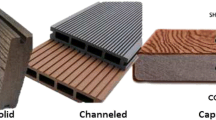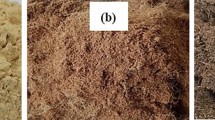Abstract
Wood and other biomass resources have been blended with thermoplastic such as polyethylene, polypropylene, polylactic acid and polyvinyl chloride to form wood plastic composites (WPC). WPCs have seen a large growth in the United States in recent years mainly in the residential decking market with the removal of CCA treated wood decking from residential markets. While there are many successes to report in WPCs, there are still some issues that need to be addressed before this technology will reach its full potential. This technology involves two different types of materials; one hygroscopic (biomass) and one hydrophobic (plastic) so there are issues of phase separation and compatiblization. This technology also involves two very different industries; wood and/or agricultural industries and plastic industries. Processing the two phases presents issues centered on maximizing mixing while minimizing damage to the biomass furnish. Melt flow index, processing temperatures, static electricity and density are also issues for the plastic industry which is used to high flowing high temperature processing conditions necessary when they either extrude plastics neat or use inorganic fillers such as glass, calcium carbonate or talc. While the biomass in the composite swells and shrinks due to moisture, the plastic phase swells and shrinks due to temperature. Freezing and thawing cycles also cause problems as well as the effects of microorganism attack and ultraviolet radiation. Dyeing, refinishing, color stability and fasteners are also concerns. Solid extrusion, profile extrusion, co-extrusion, injection molding and thermal molding are all being used to make different WPC products in different parts of the world.









Similar content being viewed by others
References
Caulfield DF, Clemons C, Jacobson RE, Rowell RM (2005) Wood-thermoplastic composites. In: Rowell RM (ed) Handbook of wood chemistry, wood composites, chap 13. Taylor and Francis, Boca Raton, pp 365–380
Jacobson RE, Rowell R, Caulfield D, Sanadi AR (1995) United States based agricultural “waste products” as fillers in a polypropylene homopolymer. Proceedings, second biomass conference of the Americas: energy, environment, agriculture, and industry. Portland, OR, NREL/CP-200–8098, DE95009230, pp 1219–1227
Smith PM, Walcott MP (2006) Opportunities for wood/natural fiber-plastic composites in residential and industrial applications. Forest Prod J 56(3):4–11
Clemons C (2002) Wood-plastic composites in the United States: the interfacing of two industries. Forest Prod J 52(6):10–18
Guo G, Rizvi GM, Park CB, Lin WS (2004) Critical processing temperature in the manufacture of fine-celled plastic/wood-fiber composite foams. J Appl Polym Sci 91:621–629
Rowell RM, Lange SE, Jacobson RE (2000) Weathering performance of plant-fiber thermoplastic composites. Mol Cryst Liquid Cryst 353:85–94
Lundin T (2001) Effect of accelerated weathering on the physical and mechanical properties of natural-fiber thermoplastic composites. M.S. thesis. University of Wisconsin, Madison
Falk RH, Lundin T, Felton C (2002) Accelerated weathering of natural fiber-thermoplastic composites: effects of ultraviolet exposure on bending strength and stiffness. Proceedings sixth international conference on woodfiber-plastic composites. Forest Products Society, Madison, pp 87–93
Malvar LJ, Pendleton DE, Tichy R (2001) Fire issues in engineered wood composites for naval waterfront facilities. Sampe J 37(4):70–75
Stark NM, White RH, Clemons CM (1997) Heat release rate of wood-plastic composites. Sampe J 33(5):26–31
Sanadi AR, Caulfield DF, Jacobson RE, Rowell RM (1994) Reinforcing polypropylene with agricultural fibers. Proceedings: international jute and allied fibre symposium on biocomposites and blends. New Dehli, India, pp 163–167
Author information
Authors and Affiliations
Corresponding author
Additional information
The Forest Products Laboratory is maintained in cooperation with the University of Wisconsin. This manuscript was written and prepared by U. S. Government employees on official time and is therefore in the public domain and not subject to copyright.
Rights and permissions
About this article
Cite this article
Rowell, R.M. Challenges in Biomass–Thermoplastic Composites. J Polym Environ 15, 229–235 (2007). https://doi.org/10.1007/s10924-007-0069-0
Published:
Issue Date:
DOI: https://doi.org/10.1007/s10924-007-0069-0




